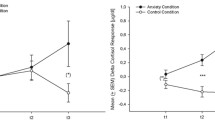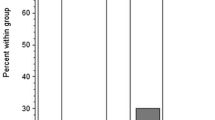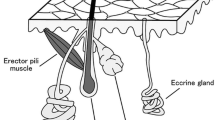Summary
The responsiveness of eccrine sweat glands to local intradermal injections of carbachol was studied in six male healthy volunteers using a plastic paint impression method. A psychological “stressor” (performance of a mental arithmetic task) resulted in an increase in the sizes of the responses evoked by carbachol, this being reflected in a higher value of Emax obtained under the “stress” than under the “non-stress” condition. A rise in ambient temperature from 20°C to 35°C resulted in qualitatively similar effects on the dose-response curve. These results are discussed in the context of recent observations on the pharmacological responsiveness of sweat glands in patients suffering from anxiety neurosis.
Similar content being viewed by others
References
Allen JA, Armstrong JE, Roddie IC (1973) The regional distribution of emotional sweating in man. J Physiol 235: 749–759
Benjamin FB (1953) Sweating responses to local heat application. J Appl Physiol 5: 594–598
Bini G, Hagbarth KE, Hynniken P, Wallin BG (1980) Regional similarities and differences in thermoregulatory vaso- and sudomotor tone. J Physiol 306: 553–565
Clubley M, Bye CE, Henson T, Peck AW, Riddington C (1978) A technique for studying the effects of drugs on human sweat gland activity. Eur J Clin Pharmacol 16: 221–226
Collins KJ, Crockford GW, Weiner JS (1966) The local training effect of secretory activity on the response of eccrine sweat glands. J Physiol 184: 203–214
Dobson RL, Sato K (1972) The stimulation of eccrine sweating by pharmacologic agents. In: Montagne W, Stoughton RB, van Scott EJ (ed), Pharmacology and the skin. Appleton-Century-Crofts, New York, pp 447–475
Gronwall DMA, Sampson H (1974) The psychological effects of concussion. Auckland University Press/Oxford University Press
Iskandar S, Bradshaw CM, Szabadi E (1980) The responsiveness of sweat glands to carbachol in anxiety neurosis. Br J Clin Pharmacol 10: 303–305
Johnson BB, Johnson RE, Sargent F (1969) Sodium and chloride in eccrine sweat of men and women during training with acetyl-beta-methylcholine. J Invest Dermatol 53: 116–121
Kuno Y (1934) The physiology of human perspiration. Churchill London
Lader MH (1975) The psychophysiology of mental illness. Routledge and Kegan Paul, London
Lamb K, Bradshaw CM, Szabadi E (1983) The responsiveness of human eccrine sweat glands to choline and carbachol: application to the study of peripheral cholinergic functioning in Alzheimer-type dementia. Eur J Clin Pharmacol 24: 55–62
Lewis D (1960) Quantitative methods in psychology. McGraw-Hill New York
MacIntyre BA, Bullard RW, Banerjee M, Elizondo R (1968) Mechanism of enhancement of eccrine sweating by localised heating. J Appl Physiol 25: 253–260
Maple S, Bradshaw CM, Szabadi E (1982) Pharmacological responsiveness of sweat glands in anxious patients and healthy volunteers. Br J Psychiatr 141: 154–161
Ogata K, Ichihashi T (1935) Sweat reflexes due to changes in posture of the human body. J Orient Med 3: 95–97
Randall WC, Kimura KK (1955) The pharmacology of sweating. Pharmacol Rev 7: 365–397
Rickles WH, Day JL (1968) Electrodermal activity in non-palmar skin sites. Psychophysiology 4: 421–435
Sato K (1977) The physiology, pharmacology, and biochemistry of the eccrine sweat gland. Rev Physiol Biochem Pharmacol 79: 51–131
Szabadi E, Gaszner P, Bradshaw CM (1980) Comparison of the effects of adrenoceptor and cholinoceptor agonists on sweat gland activity in man. Br J Clin Pharmacol 10: 301–303
Thomson ML, Sutarman (1953) The identification and enumeration of active sweat glands in man from plastic impressions of the skin. Trans R Soc Trop Med Hyg 47: 412–417
van den Broek MD, Bradshaw CM, Szabadi E (1983) The responsiveness of sweat glands to carbachol: effects of a psychological ‘stressor’ and raised ambient temperature. Br J Clin Pharmacol 15: 603–604 P
Wilcott RC (1963) Effects of high environmental temperature on sweating and skin resistance. J Comp Physiol Psychol 56: 778–782
Wilcott RC (1967) Arousal sweating and electrodermal phenomena. Psychol Bull 67: 58–72
Wilinson GN (1961) Statistical estimations in enzyme kinetics. Biochem J 80: 324–332
Author information
Authors and Affiliations
Rights and permissions
About this article
Cite this article
van den Broek, M.D., Bradshaw, C.M. & Szabadi, E. The effects of a psychological “stressor” and raised ambient temperature on the pharmacological responsiveness of human eccrine sweat glands: Implications for sweat gland hyper-responsiveness in anxiety states. Eur J Clin Pharmacol 26, 209–213 (1984). https://doi.org/10.1007/BF00630287
Received:
Accepted:
Issue Date:
DOI: https://doi.org/10.1007/BF00630287




